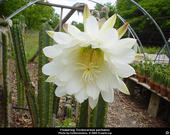The San Pedro cactus is the name given to psychoactive species of the genus Trichocereus (T. pachanoi, T. peruvianus) which comprises about thirty species, mainly found in the Andes. It is a large columnar cactus that grows up to heights of twenty feet and it contains mescaline, as does the well-known peyote cactus. The San Pedro cactus has also been found to have other psychoactive alkaloids. The mescaline seems to be most highly concentrated in the skin, which can be peeled, dried and made into a powder for consumption.The usual native preparation of the cactus involves boiling slices of the stem for a number of hours and then, once cooled, the resulting liquid is drunk. Sometimes the San Pedro is used in conjunction with other psychoactive plants, such as coca, tobacco, Brugmansia and Anadenanthera. The hallucinogenic properties of its traditional use, including aguacolla, cardo, cuchuma, gigantn, hermoso, huando and, of course, San Pedro.Like many other of the entheogenic substances used in the aboriginal religions of the Americas, the use of the hallucinogenic San Pedro cactus is ancient and its use has been a continuous tradition in Peru for over 3,000 years. The earliest depiction of the cactus is a carving which shows a mythological being holding the San Pedro. It belongs to the Chavn culture (c. 1400-400 BC) and was found in an old temple at Chavn de Huantar in the northern highlands of Peru, and dates about 1300 BC. A particularly surprising discovery was made by a Peruvian archaeologist named Rosa Fung in a pile of ancient refuse at the Chavn site of Las Aldas near Casma; namely what seem to be remnants of cigars made from the cactus. Artistic renderings of it also appear on later Chavn artefacts such as textiles and pottery (ranging from about 700-500 BC). The San Pedro is also a decorative motif of later Peruvian ceramic traditions, such as the Salinar style (c. 400-200 BC), the Nasca urns (c. 100 BC-AD 700). It has also been proposed that a recurrent snail motif in Moche art represents a mescaline-soaked snail which has partaken of the San Pedro. If this is the case then the snail may be added to the list of animals having psychoactive properties.Not surprisingly, considering their general contempt for native life and particularly the use of psychoactive plants, European missionaries were very negative when reporting the use of the San Pedro. Yet a Spanish missionary, cited by Christian Rtsch, grudgingly admitted the cactus' medicinal value in the midst of a tirade reviling it:it is a plant with whose aid the devil is able to strengthen the Indians in their idolatry; those who drink its juice lose their senses and are as if dead; they are almost carried away by the drink and dream a thousand unusual things and believe that they are true. The juice is good against burning of the kidneys and, in small amounts, is also good against high fever, hepatitis, and burning in the bladder.
An account of the cactus by a shaman is in radical contrast to this rather contemptuous view:the drug first ... produces ... drowsiness or a dreamy state and a feeling of lethargy ... a slight dizziness ... then a great 'vision', a clearing of all the faculties ... it produces a light numbness in the body and afterward a tranquillity. And then comes detachment, a type of visual force ... inclusive of all the senses ... including the sixth sense, the telepathic sense of transmitting oneself across time and matter ... like a kind of removal of one's thought to a distant dimension.
The entheogenic status of the cactus remains as strong today as it always was. Not only do its uses in shamanic trances and healing sessions continue but it is also used to combat more recent problems such as alcoholism. The peyote cactus used widely by the North American Indians is also considered a medicine against alcoholism and this parallel is all the more striking as both cacti contain mescaline.
I edited my profile with Thomas Myspace Editor V3.6 !
